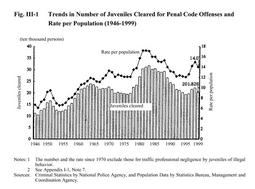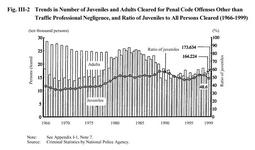| Previous Next Index Image Index Year Selection | |
|
|
1 Number of cleared juveniles Fig. III-1 shows the number of juveniles cleared for penal code offenses and their percentage of the total population(the number of cleared juvenile offenders per 1,000 persons aged 10 or over but less than 20) since 1946 (see Appendix III-1 ).
The number of juveniles cleared for penal code offenses has experienced three cycles, the first peaking in 1951 at 166,433, the second in 1964 at 238,830, and the third in 1983 at 317,438. Following a downward trend recorded since 1984, both the number and rate of juveniles cleared by the police turned up in 1996, only to decline again in 1999. 201,826 juveniles were cleared in that year(down 8.8% from the previous year), equivalent to 14.0 per 1,000 juveniles (down1.0). Fig. III-2 shows the number of juveniles and adults cleared for penal code offenses other than traffic professional negligence as well as the ratio of juveniles cleared(the ratio of juveniles cleared for penal code offenses to the total number of persons cleared, including adults and juveniles of illegal behavior) since 1966, the year in which Criminal Statistics by National Police Agency became focused on penal code offenses excluding traffic professional negligence. Fig. III-1 Trends in Number of Juveniles Cleared for Penal Code Offenses and Rate per Population (1946-1999) After peaking at just over 260,000 in 1983, the number of juveniles cleared for penal code offenses other than traffic professional negligence showed a downward trend, albeit with some fluctuation. Although the number increased from 1996 to 1998, it fell again in 1999 to 164,224 (down 10.9% from the previous year).Fig. III-2 Trends in Number of Juveniles and Adults Cleared for Penal Code Offenses Other than Traffic Professional Negligence, and Ratio of Juveniles to All Persons Cleared (1966-1999) The ratio of juveniles in the total number of persons cleared surpassed 50% in 1981. Subsequently, the number of juveniles cleared continued to exceed that of adults, with the exception of 1984. From 1993 to 1996, however, the ratio of juveniles remained below 50%. After exceeding 50% again in 1997 and 1998, it fell to48.6% in 1999. |

